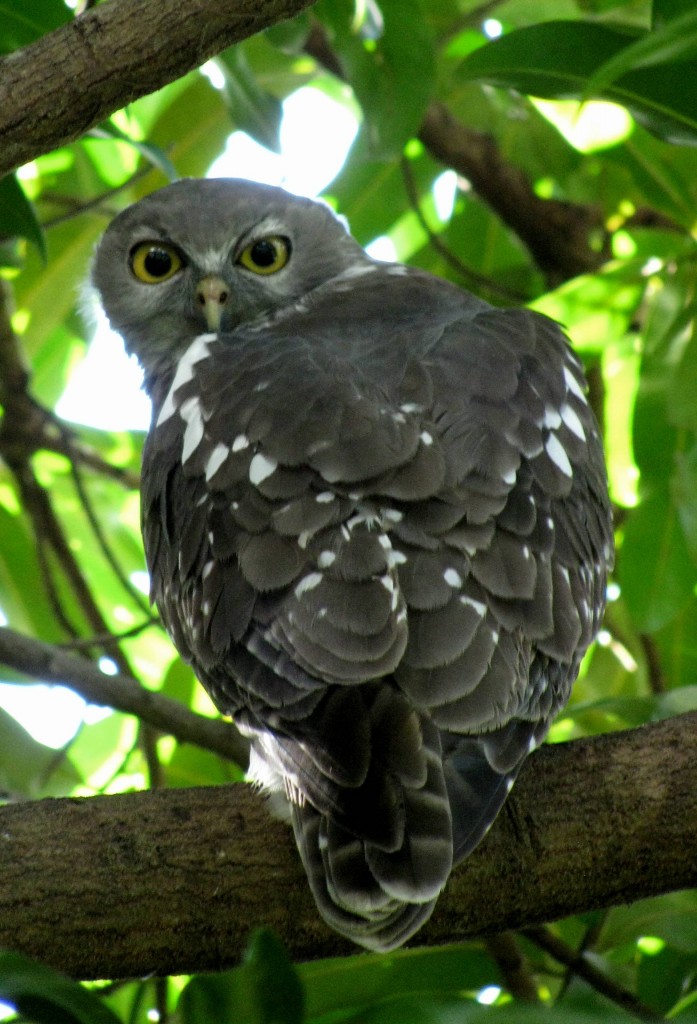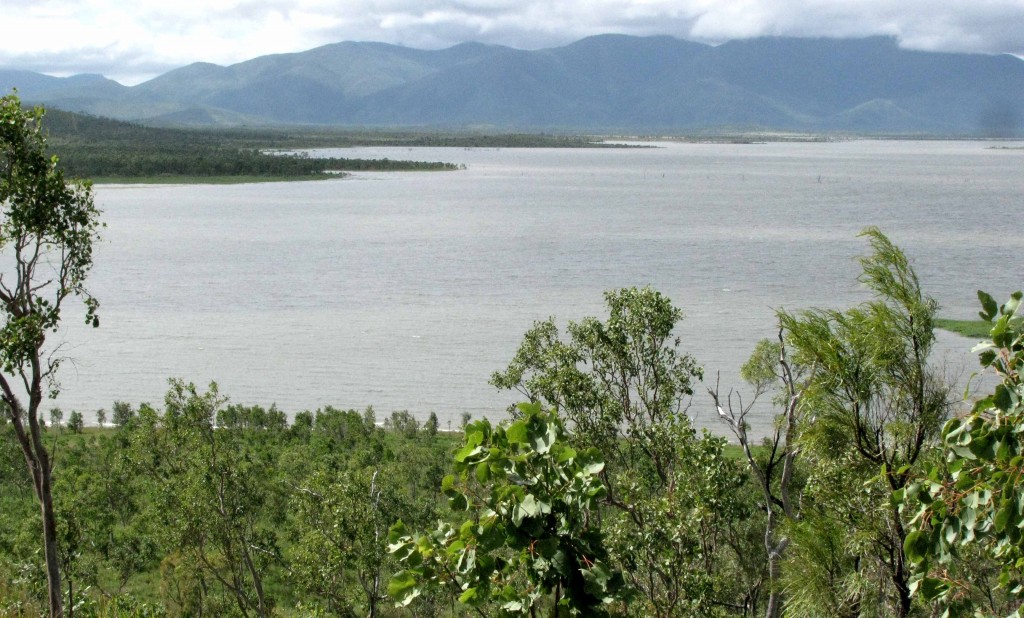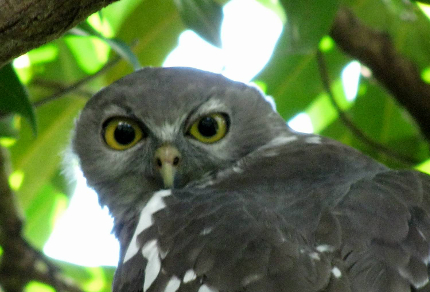
Barking Owl in Palmeturm Park, Townsville (© Magi Nams)
Silence, I have discovered, is a rare commodity in the tropical night. With the passing of the Wet, frog operas have ceased, and thus, the dark hours are starker, no longer vibrating with wild rain-worship music and the lusting come-hither of anurans. Still, in the darkness of late night, all week I have heard the puckered “Chuck-chuck-chucks” of Asian house geckos in my yard and the mad wails of bush stone-curlews on the golf course. Yet, there has been a new sound, too, a repeated “wak-wak” I liken to the insistent barking of a small dog. That last sound, I believe, is the call of the barking owl, for which I have been listening ever since a graduate student I spoke with six weeks ago at James Cook University mentioned that barking owls can be heard in Townsville during the winter. This morning, I heard not one barking voice, but two of different pitches, which I believe were male and female barking owls performing a bonding duet.
According to my bird guide1, from which all of the following descriptive information is derived, Australia is home to nine species of owls, with six (possibly seven) of these species occurring in the Townsville area. Of these half-dozen species, four possess prominent heart-shaped, dark-bordered facial discs or masks that surround the owls’ eyes and beaks. The most familiar owl with such a facial disc is the barn owl, which occurs throughout the world. The masked owls inhabiting the Townsville region include the barn owl, the darker grass owl, the small, silver-grey lesser sooty owl, and possibly the big, burly masked owl. Two of Townsville’s other owls appear to wear dark goggles – the big, rusty-coloured rufous owl and the much smaller brown southern boobook, with its heavily-streaked belly. The guide’s illustrations show the barking owl wearing neither mask nor goggles, but looking out at the world from brilliant yellow eyes. Its plumage is brown or grey, with a white, heavily streaked belly.
Owls, being generally nocturnal creatures, are difficult to locate in order to identify them by sight. They do, however, emit distinctive calls – particularly during the courtship season – which can be used to distinguish one species from another. My guide describes the voice of the barking owl as just what I heard – an “unmistakeable, quick, dog-like ‘wok-wok’ or ‘wook-wook’” – and includes descriptions for the calls of the other owls occurring in this area, those sounds ranging from the “whoo-hooo” of the rufous owl to the lesser sooty owl’s “falling bomb whistle.”2 In Canada, I conducted hooting surveys in Nova Scotia as part of the Maritime Breeding Bird Atlas. It would be intriguing to do something similar here.

Lake Ross (© Vilis Nams)
After breakfast, Vilis and I walked near the shore of Ross Lake for hours, revelling in butterflies that glided, flitted, and hovered above the pathside herbs like an aerial dance troupe. We spotted a chocolate argus, several male varied eggflies – like the one that tore at my heart at Borrow Pits last weekend – as well as clear-winged swallowtails, grass yellows, and others too swift to photograph and unwilling to remain motionless long enough to be identified.

Golden Orb Web Spider near Ross Lake (© Vilis Nams)
Vilis also spotted a huge spider hung like an arachnid grim reaper with a death net strung between earth and sky. A good 10 centimetres in overall length, the spider, which I later identified as a golden orb web spider (so named because it produces golden silk), possessed a shiny white abdomen, long brown legs that appeared to belong to some other creature, and arrays of eyes. It remained motionless on its shimmering silky trap positioned between two trees while Vilis photographed it. Two tiny spiders that were probably males of the same species occupied the outer limits of the web. Above the big arachnid, a string of silk-bound debris hung, likely the sucked-out bodies of prey items. The scene was vaguely reminiscent of Shelob’s lair in The Lord of the Rings, but even Australia doesn’t have spiders that big.
Today’s birds: bush stone-curlews, barking owls (voices), rainbow lorikeet, magpie-larks, Australian magpie, helmeted friarbird, yellow-throated miner, masked lapwings, peaceful doves, rock pigeons, little black cormorants, little egret, mynas, blue-faced honeyeater, black-faced cuckoo-shrike, pied imperial-pigeon, figbird, sulphur-crested cockatoos, whistling kite, great-crested grebes, great egret, Pacific black ducks, black kite. Also Asian house geckos, varied eggfly, clear-winged swallowtails, golden orb web spider, eastern grey kangaroos.
Reference:
1. Graham Pizzy and Frank Knight. 2000. The Graham Pizzy & Frank Knight Field Guide to the Birds of Australia. Angus & Robertson, Sydney. pp. 300-307; 2. Ibid. pp. 302, 300, 304.


